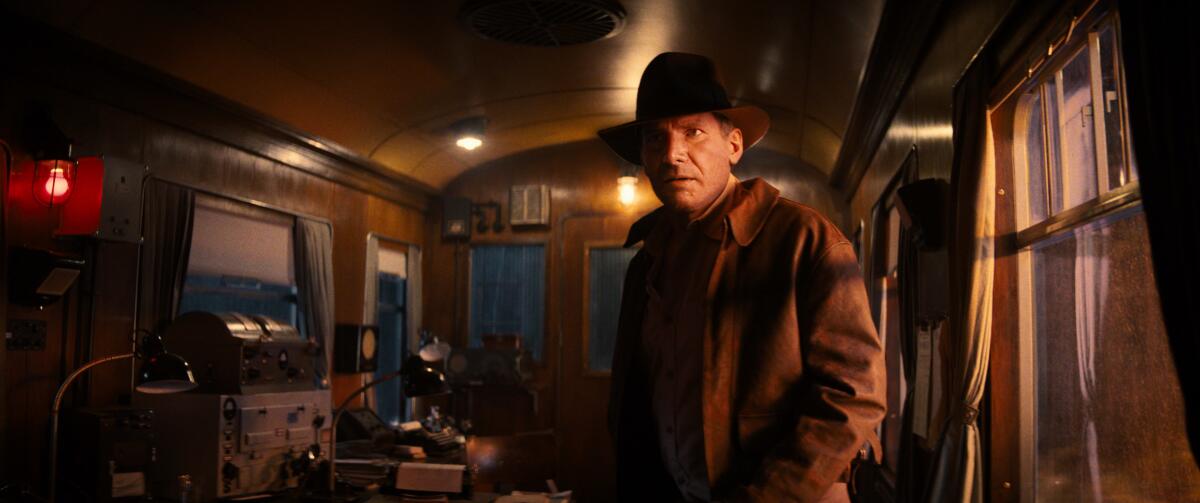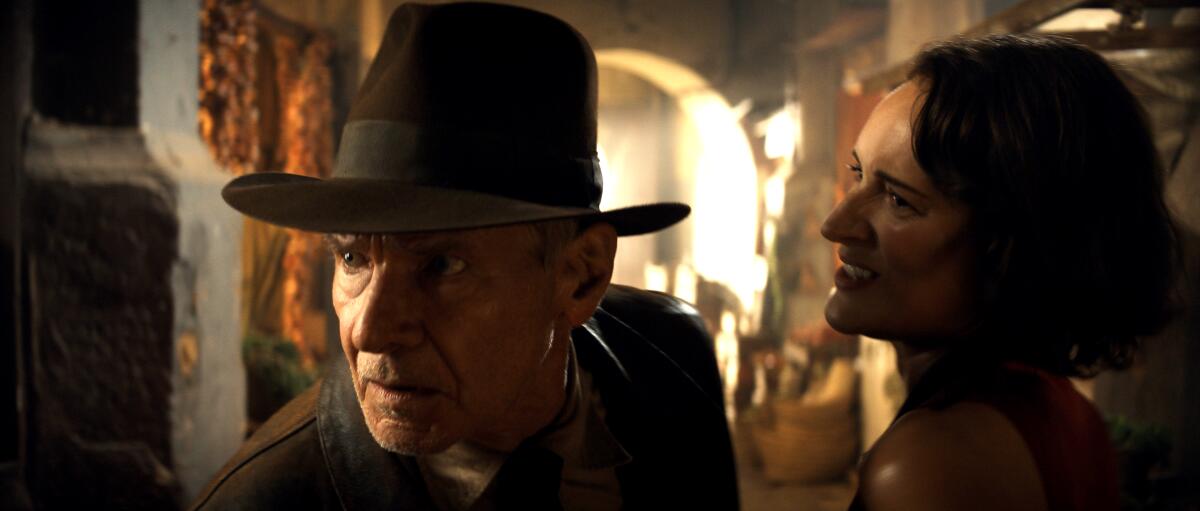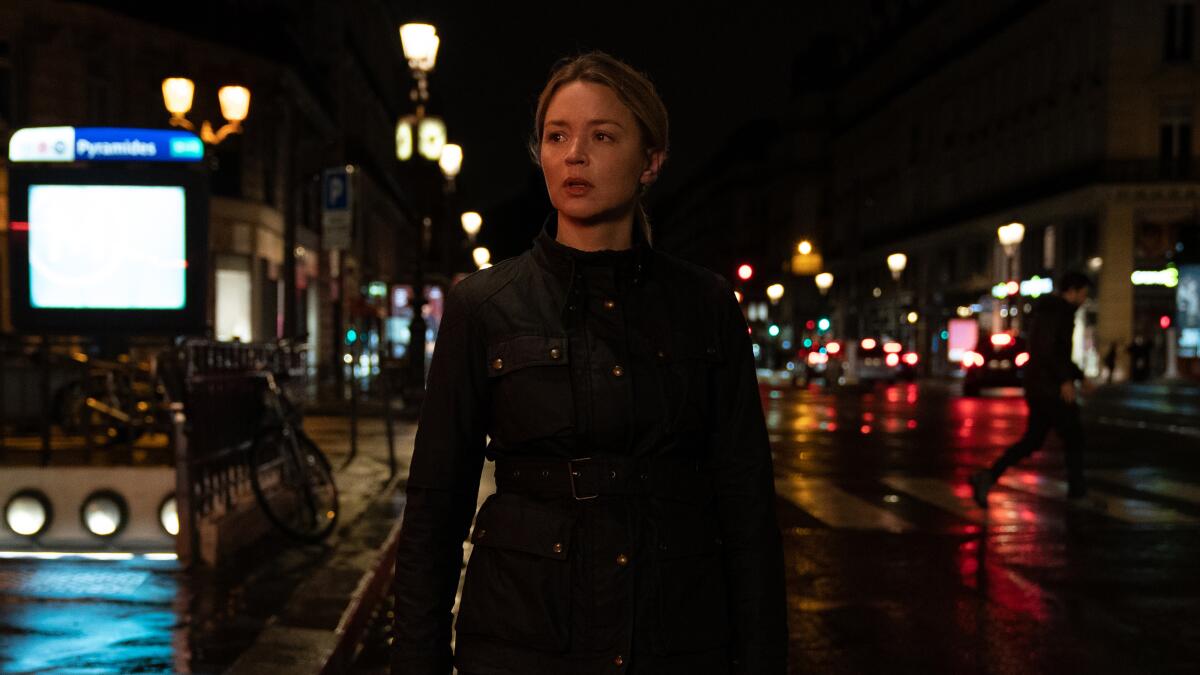One more adventure for ‚ÄėIndiana Jones and the Dial of Destiny‚Äô

Hello! I’m Mark Olsen. Welcome to another edition of your regular field guide to a world of Only Good Movies.
The situation around Turner Classic Movies that we discussed here last week has continued to evolve, as Stephen Battaglio reported on the announcement that the creative side of the network will be under Warner Bros. Pictures Group co-heads Michael De Luca and Pamela Abdy. Programming chief Charles Tabesh will remain at the channel, while filmmakers Steven Spielberg, Paul Thomas Anderson and Martin Scorsese will have a formal role in curation and scheduling.
Michael Hiltzik took a step back on why TCM matters. ‚ÄúThey are the keepers of the flame,‚ÄĚ said Foster Hirsch, a professor of film at Brooklyn College. ‚ÄúThey‚Äôre an enormous resource for scholars and writers and fans of all ages. To start tampering with the brand or to view it in terms of marketing and data exclusively is horrifying. It‚Äôs an assault on our common culture.‚ÄĚ
Jean Eustache at last. With the rights issues that had long kept his work from being widely seen cleared up, the films of Jean Eustache are at last being made available, presented in a traveling program as ‚ÄúThe Dirty Stories of Jean Eustache‚ÄĚ that is playing locally at the American Cinematheque. While ‚ÄúThe Mother and the Whore,‚ÄĚ Eustache‚Äôs epic of post-‚Äô60s disillusionment starring Jean-Pierre L√©aud, Bernadette Lafont and Fran√ßoise Lebrun, is by far his best-known work, this is an even more rare chance to see films such as ‚ÄúMy Little Loves‚ÄĚ and ‚ÄúNum√©ro Z√©ro.‚ÄĚ
Regeneration remix. The Academy Museum‚Äôs exhibition ‚ÄúRegeneration: Black Cinema 1898-1971‚ÄĚ will be closing in a few weeks, and the museum has launched a new film series to close things out, ‚ÄúRegeneration, Remixed.‚ÄĚ Among the films will be Jordan Peele‚Äôs ‚ÄúNope‚ÄĚ on 70 millimeter, Charles Lane‚Äôs ‚ÄúSidewalk Stories‚ÄĚ and an archival assembly of 1914‚Äôs ‚ÄúLime Kiln Club Field Day,‚ÄĚ the earliest surviving feature-length film with an all-Black cast, presented with a conversation with Ron Magliozzi, curator of film at the Museum of Modern Art to talk about the film‚Äôs rediscovery and restoration.
LAT doc shorts. A new season of The Times Short Docs program has launched with ‚ÄúMerman,‚ÄĚ a portrait of Palm Springs resident Andr√© Chambers depicting his life as a queer Black man in Southern Calfornia. Directed by Sterling Hampton, the film recently premiered at the Tribeca Film Festival.
Enjoying this newsletter? Consider subscribing to the Los Angeles Times
Your support helps us deliver the news that matters most. Become a subscriber.
‚ÄėIndiana Jones and the Dial of Destiny‚Äô
Directed and co-written by James Mangold, ‚ÄúIndiana Jones and the Dial of Destiny‚ÄĚ is the fifth adventure for the intrepid professor-archaeologist ‚ÄĒ and the first not directed by Steven Spielberg. Set mostly in 1969, ‚ÄúDial‚ÄĚ features Dr. Jones (Harrison Ford) in search of an artifact said to allow time travel, aided by his goddaughter Helena Shaw (Pheobe Waller-Bridge). They‚Äôre in a race against a former Nazi scientist (Mads Mikkelsen). The film is in theaters now.
For The Times, Justin Chang wrote, ‚ÄúIn a way, Indy has been swallowed up by not only the very action-comedy movie formula he helped normalize but also by the dispiriting, depersonalizing trends in 21st-century studio filmmaking. The greatness of ‚ÄėRaiders‚Äô and parts of the original trilogy lay in qualities you rarely encounter in movies anymore: their jaunty exuberance, the arresting physicality of their action and the tactile creepiness of their practical effects. ‚Ķ But as a meditation on Indy‚Äôs (and Ford‚Äôs) mortality, on the passage of time and the plasticity of the motion-picture medium, [‚ÄėDial of Destiny‚Äô is] an unexpectedly, even accidentally resonant piece of work, especially as it gradually finds its footing in the final stretch and sprints toward a loopily audacious climax.‚ÄĚ
Mary McNamara interviewed Ford for 45 minutes in a Los Angeles hotel room during a chaotic press junket. Ford made no attempt to hide the fact he doesn‚Äôt much like promoting his films and likes even less talking about himself. Nevertheless, he had a job to do. ‚ÄúI‚Äôm in it for the money, and I mean that in the best possible way.‚ÄĚ he said. ‚ÄúI want my films to succeed. For me and for all the people who work on them, even the people who put money in. But mostly I want the films to succeed for the audience. Because that is why we tell stories.‚ÄĚ
Mary also spoke to Karen Allen, who returns to her ‚ÄúRaiders‚ÄĚ role as Marion Ravenwood. ‚ÄúI think [Lucas and Spielberg] created these indelible characters,‚ÄĚ Allen said. ‚ÄúThis archaeologist who‚Äôs off the beaten path ‚ÄĒ he knocks out a Nazi and when he tries to put on the uniform it‚Äôs too small. It won the hearts of people. The stories are modern and kind of a throwback, and Marion is his partner from the beginning.‚ÄĚ
For the New York Times, Manohla Dargis wrote, ‚ÄúIt‚Äôs hard to believe this or any other installment would have worked half as well without Ford, whose gruffly appealing, unthreatening (to women, importantly) masculine persona has always felt natural and unforced. No matter how outrageous Indy‚Äôs trouble, Ford‚Äôs persona and outwardly effortless charm ‚ÄĒ and his ability to drop that rakish smile for something darker, meaner, even threatening ‚ÄĒ have kept the character tethered to the real world of feelings and consequences. Lucas and Spielberg sketched a cartoon; Ford created a character. That character, or rather Ford, or really the two of them together are the main arguments for seeing ‚ÄėDial of Destiny,‚Äô which is as silly as you expect and not altogether as successful as you may hope.‚ÄĚ
For Vulture, Bilge Ebiri wrote, ‚ÄúNot unlike ‚ÄėThe Force Awakens‚Äô did with the original Star Wars, the ‚ÄėDial of Destiny‚Äô feels at times like a remix, offering variations on elements from earlier ‚ÄėIndiana Jones‚Äô movies. ‚Ķ Still, the damn thing is fun. Mangold may not have the young Spielberg‚Äôs musical flair for extravagant action choreography (who does?), but he is a tougher, leaner director, using a tighter frame and keeping his camera close. That may shortchange the escapist atmosphere and evocative exotica of the material (which is, after all, one of the pleasures of ‚ÄėIndiana Jones‚Äô movies), but it does bring a ground-level immediacy to the action.‚ÄĚ

‚ÄėRevoir Paris‚Äô
Directed and written by Alice Winocour, ‚ÄúRevoir Paris‚ÄĚ (also translated as ‚ÄúParis Memories‚ÄĚ) won the French C√©sar award for its leading actress Virginie Efira. She plays Mia, a woman whose life is sent into turmoil after she survives a terrorist attack. Unsure of what truly happened to her that fateful night, she attempts to reconstruct the event by reaching out to fellow survivors. The film is in theaters now.
For The Times, Robert Abele wrote, ‚ÄúSuch first-person empathy for the nuts and bolts of reestablishing a forever-changed life carries ‚ÄėRevoir Paris‚Äô across its epiphanies and diversions, from the far-off look Mia slips into ‚ÄĒ a quietly forceful key to Efira‚Äôs intelligent, on-the-go performance ‚ÄĒ to interludes narrated by other survivors about the closure they‚Äôre seeking. ‚Ķ It‚Äôs this journey that Winocour makes into something truly heart-rending: a story of the Paris hiding in plain sight, lives of struggle, indispensability and endurance that shouldn‚Äôt need communal torment and headlines to spur others to regard in their fullness. It‚Äôs in that soulful shift from repair‚Äôs confusion to renewal‚Äôs fullness where ‚ÄėRevoir Paris‚Äô is most powerful, dramatizing what it can mean to outlive something unimaginable ‚ÄĒ and look at the world anew.‚ÄĚ
For rogerebert.com, Jourdain Searles wrote, ‚ÄúAs Mia, Efira gives a subdued performance enhanced by her expressive face. ‚Ķ ‚ÄėRevoir Paris‚Äô is a story about people thrown together, forever changed by their time together. In addition to its emotional resonance, the film highlights Paris‚Äô cultural and economic diversity as we watch Mia interact with people she may have never met. Despite the tragedy, ‚ÄėRevoir Paris‚Äô is a hopeful film about the healing power of human connection and mutual comfort. It‚Äôs the kind of movie that lingers in the mind long after the credits roll.‚ÄĚ
For Variety, Guy Lodge wrote, ‚ÄúIt‚Äôs a modest film with a heart very much on its torn sleeve, given force and ballast by another fine dramatic turn from the hard-working Virginie Efira. If centering the story on a fictitious tragedy frees Winocour from some of the moral and political challenges of dramatizing raw real-life wounds, ‚ÄėParis Memories‚Äô nonetheless feels thoughtfully shaped by recent history and France‚Äôs response to it.‚ÄĚ

‚ÄėEvery Body‚Äô
The new documentary ‚ÄúEvery Body‚ÄĚ focuses on the intersex community (that‚Äôs the ‚ÄúI‚ÄĚ in LGBTQIA) ‚ÄĒ people born with characteristics of both male and female sex traits. Directed by Julie Cohen, the film follows three activists (Sean Saifa Wall, River Gallo and Alicia Roth Weigel) who were all born intersex, while also exploring the medical and scientific history of our understanding of this 2% of the population. The film is in theaters now.
For The Times, Katie Walsh wrote, ‚Äú[The film] becomes a radical text, a crucial component in our evolving understanding of gender, and an important representation of the intersex experience. ‚Ķ The intersex movement is about living fully without fear, shame or trauma, to live life on one‚Äôs own terms, and the brightness and vigor that Cohen applies to the tone follows the energy of the activists themselves. At the end, Cohen asks this trio to ‚Äėfrolic‚Äô in a moment of much-needed, much-deserved and fully embodied joy that represents a little-seen aspect of intersex life and captures the spirit of what the leaders of this movement are fighting for in the next generations.‚ÄĚ
For the New York Times, Teo Bugbee wrote, ‚ÄúThe film benefits from its choice of subjects, as Wall, Gallo and Weigel are all endearing and deeply informed. Their candor animates the unimaginative talking head interview footage from the director Julie Cohen (‚ÄėRBG‚Äô). But beyond casting, Cohen‚Äôs best directorial choice is to show examples from the history of intersex medical care.‚ÄĚ
For the Hollywood Reporter, Lovia Gyarkye wrote, ‚ÄúThe film debunks common misconceptions about what it means to be intersex and covers the bitter history of intersex people being treated as ‚Äėfreaks‚Äô and mislabeled as ‚Äėhermaphrodites‚Äô The analysis paints a painful portrait and illuminates the dehumanizing treatment faced by intersex people. ‚Ķ ‚ÄėEvery Body‚Äô is primarily an informative documentary, one that takes a cursory glance at many facets of the intersex awareness conversation to give viewers unfamiliar with the material a new perspective. Cohen and her team connect the dots for us, too, which helps us understand how solidarity with intersex people helps in the broader fight for bodily autonomy.‚ÄĚ

Only good movies
Get the Indie Focus newsletter, Mark Olsen's weekly guide to the world of cinema.
You may occasionally receive promotional content from the Los Angeles Times.




